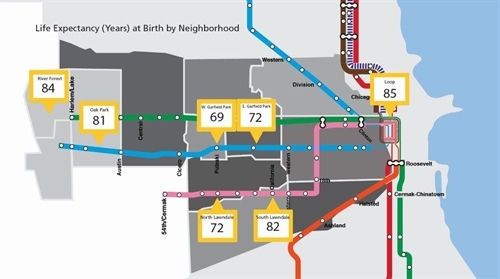The average life expectancy in Garfield Park is 16 years lower than in the Loop. At Metropolitan Planning Council’s (MPC) Urban Think & Drink on Thursday, May 18, Dr. David Ansell of Rush University highlighted his new book, The Death Gap: How Inequality Kills, and talked about what is causing the disparity in life expectancy we see across the City’s poorest and wealthiest neighborhoods.
Nearly 100 people attended the event, which was sponsored by Presence Health.

Life Expectancy (years) at Birth by Neighborhood David Ansell
Dr. Ansell gave an impassioned accounting of how systemic racial and economic discrimination, bolstered by urban planning decisions and policy, leads to early death for Chicago’s most vulnerable. For generations, some of neighborhoods have been denied access to housing, transportation, healthcare and education, while other neighborhoods have maintained or gained resources. Over time, all of this affects a community’s health: life expectancy increases in the wealthiest areas and remains stagnant elsewhere.
In addition to describing the problem, Dr. Ansell gave us solutions. To improve the situation of Chicago’s most vulnerable, we need to realize that areas of concentrated poverty cannot exist without areas of concentrated wealth. We need address racial and economic segregation, especially when it comes to public services and resources, with intentional policies. We need to increase our empathy, because it hurts all Chicagoans if part of our city is suffering.
Watch Now
MPC thanks Sponsor Presence Health and Beverage Sponsor Revolution Brewing for their generous support of this event.
